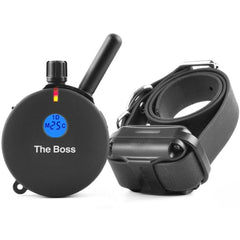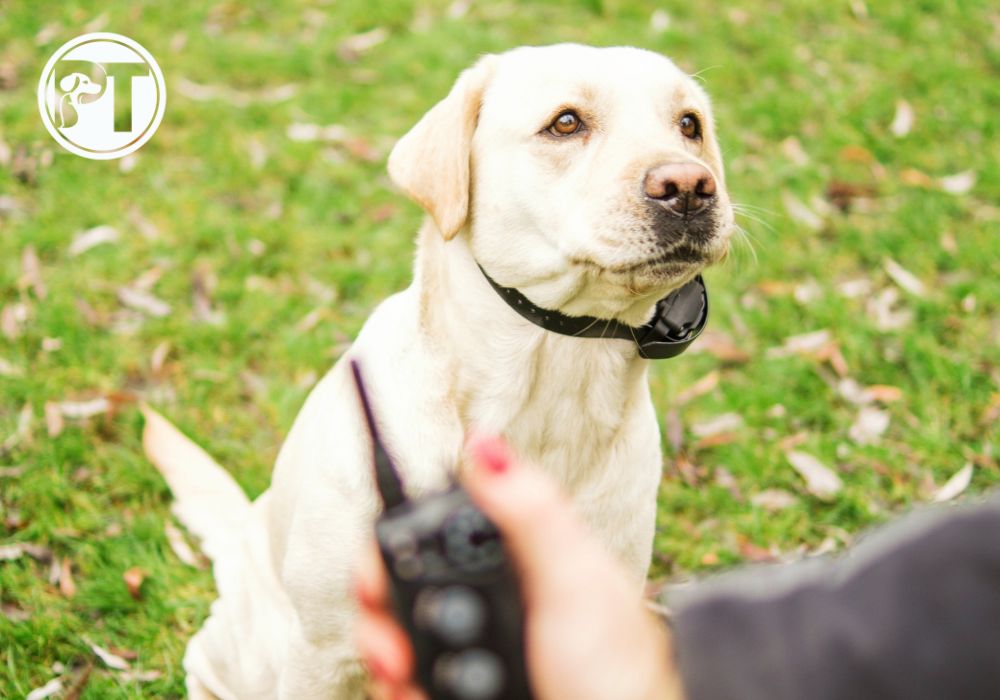How to Know if You’re Doing E-Collar Training Correctly

This article was updated on November 25, 2024.
Teaching a dog to follow commands can be a difficult task. This is often not due to your pet intentionally ignoring your cues. The challenge is how to convey your message so that they can understand.
One solution to this communication barrier is using an e collar for dogs. However, the success of the training depends heavily on how the tool is utilized.
If you’re a pet owner who wants to learn how to train with an e-collar correctly, this guide will help. This blog focuses on e-collar training, highlighting the recommended practices and common mistakes to avoid.
What Is E-Collar Training?

E-collar training is a method of teaching dogs positive behavior that involves the use of an e-collar. However, this type of dog training approach has been controversial because of the use of such electronic devices.
Despite claims suggesting otherwise, an e-collar is not a device to punish dogs. Instead, it’s a communication tool for fostering better understanding between you and your canine companion.
What Is an E-Collar?
An e-collar is known by various names, such as a remote dog training collar, dog training collar with remote, or shock collar for dogs. However, they all pertain to the same training equipment.
An e-collar works by delivering stimulation to your dog through the receiver collar. The receiver collar has prongs, which emit the correction when activated. Meanwhile, the handheld transmitter gives you the freedom of when to send the stimulation.

Dog electric collars typically come with one or more training modes:
- Static - releases electric pulses to your dog
- Vibration - delivers vibrating sensation as an alternative to static
- Tone - uses sound to redirect your dog’s attention
Benefits of E-Collar Training
E collar training has notable advantages. These are as follows:
-
Better Communication with Your Dog
An e-collar acts as a leash extension to help you communicate better with your dog. While a leash is only a few feet long, an e collar can cover as much as 1 mile (or more).
Imagine a scenario where your dog runs out your door to chase a squirrel. Your voice command may prove useless at this point. A remote dog training collar is your reliable means of connecting with your dog. A push of the transmitter button is all it takes to stop them in their tracks, diverting their attention to you.

-
Enhanced Training
Dog training collars are used to address undesirable behaviors in dogs. These include jumping on people, leash-pulling, excessive barking, and bolting. These collars are also used to reinforce previously learned dog commands. For advanced training, such as hunting and scent detection, remote trainers are valuable tools employed by hunters and professional dog trainers.

Choosing the Right E-Collar
The first order of business in e-collar training is finding the right training equipment for your dog. Due to the vast array of remote training collars available, this can be a daunting task. Understanding the crucial features to consider can assist you in making an informed buying decision.
Outlined below are some factors to keep in mind when selecting an e collar for dogs:
-
Range
Remote control is one upside of using dog electric collars. This lets you know how far your dog can go off-leash while still being able to send a correction when the need arises. Ecollars can have a few hundred yards, 1 mile, or even more. For long-distance training, you would need a mile or more. However, a range of 500 yards is more than enough for basic training at home.
-
Stimulation Levels
Multiple intensity levels allow you to find the right correction setting for your dog. You can find e collars with 100 stimulation levels or more. More settings mean small increments between levels. This allows you to fine-tune to the level that works best for your dog.
-
Training Modes
As stated earlier, a dog shock collar may provide different training options: static, vibration, and tone. Some may only have static. Others can have static and vibration or all three modes. If you’re on the fence about using static, vibration and tone are great alternatives.
-
Durability
Since most dogs love water, getting a waterproof dog training collar would be wise. Your dog may jump into the pool, or the rain could pour while you train. You never know.
-
Expandability
Most dog training collars come in a single-dog unit. However, some are expandable to accommodate several dogs in one e collar system. This gives you the flexibility and convenience to train more dogs using one remote transmitter.
-
Quality
Don’t rely on cheap trainers. Buy something of quality that won’t fail often and would last longer. Good collars cost over a hundred bucks, with you spending a few more if you want to have the best features. Dogtra, E-Collar Technologies, SportDog, and PetSafe are leading manufacturers of high-quality collars.
PetsTEK’s Picks for the Best E-Collars for Dogs
To help narrow down your choices, check out these e-collar suggestions below:
1. ET-300 Mini Educator by E-Collar Technologies

The ET-300 Mini Educator is a favorite among dog owners and trainers. It has a ½-mile range and 100 levels of static stimulation. It also comes with a tone and vibration, ideal for sensitive and hearing-impaired dogs. This shock collar is fully waterproof and rechargeable, also available in black and Educator zen 300 variants.
2. Dogtra 200NCPT PetsTEK Edition

The Dogtra 200NCPT PetsTEK Edition is an excellent choice for small to medium dogs. It has a ½-mile range, 100 stimulation levels, an audible tone, and non-stimulating vibration. Best for dogs as small as 12 pounds, it’s an e collar for basic obedience lessons and off-leash training.
3. ET-800 Boss Educator by E-Collar Technologies

The Boss Educator ET-800 is designed for large and stubborn dogs. It has a 1-mile range, 100 levels of static, and 60 levels of boost. This e collar also comes with tone and vibration for sensitive canines. It’s a waterproof collar, recommended for dogs 20 pounds and larger.
4. SportDOG SD-425X FieldTrainer

Built for basic training and hunting, the SD-425X FieldTrainer is the smallest shock collar by SportDOG. It has a 500-yard range, 21 static levels, and other training options, including tone and vibration. This is an expandable trainer for up to 3 dogs.
5. Dogtra 1900S

The Dogtra 1900S is known for its versatility and durability. Whether for obedience, competition, or K9 training, this e collar is dependable, with 127 levels of stimulation. Great for dogs 35 pounds and larger, this training collar for dogs has a 3/4-mile radius and is fully waterproof. It also comes in a camo and black finish.
How to Conduct E-Collar Training Effectively
While e-collars may seem straightforward, it's important to know the recommended practices of e-collar training to achieve optimal results.
Here’s a guide to help you out:
1. Start with the Basics

Choosing the right dog collar does not guarantee dog training success right off the bat. A remote dog training collar is used to reinforce the commands your dog has already learned. Hence, you must teach your dog the essential cues you want your pet to know. Only supplement the training with an e collar once they know the basic commands.
2. Familiarize Yourself with the E-Collar

Before using the training collar for dogs, learn how it works first. Read your e-collar manual and familiarize yourself with the transmitter, including its buttons, dial, and switch. Knowing how to operate your equipment will allow you to make consistent and immediate corrections.
3. Introduce the E-Collar to Your Dog

Before activating the e-collar, let your dog become familiar with the collar first. Don’t turn it on for at least a few days or a week. Go for a walk or play ball. This ensures your pet won’t associate the collar with something negative later.
4. Fit the Collar Correctly

Make sure the shock collar is fitted well around your dog’s neck. If the fit is too loose, you won’t get reliable contact. The correction would be inconsistent in this case. If it’s too tight, your dog may get skin irritation or pressure sores on their neck.
Ensure that your dog is comfortable wearing the equipment for long hours. However, it’s recommended not to leave the collar on your dog for more than 10 hours to avoid issues.
5. Find Your Dog’s Recognition Level

In e collar training, you want to maintain communication with your dog even at a distance. The goal is for your dog to associate your commands with the stimulation. To achieve this, you must find the level where your dog would exhibit a subtle change of behavior.
Dog reactions could be as follows:
- Ear flick
- Head tilt
- Confused look
- Any mild response
To find the right stimulation level, start at the lowest level and gradually dial up. If you’ve noticed your pet yelping or looking scared, the level is too high. Lower the stimulation level until you get a milder response. There may be times when you need to increase the stim level, especially during highly-distracting situations.
6. Incorporate Positive Reinforcement

It’s good to instill positive associations in your training. This doesn't mean you need to reward your dog with treats nonstop. A few treats or toys from time to time would suffice. This keeps them motivated about the training and shoots their energy up.
7. Be Fair to Your Dog

Don't get ahead of yourself. Your dog doing an excellent job at home doesn’t necessarily mean they could do the same in other places. There are many distractions outside, such as people, noises, smells, etc. These could be overwhelming for your furry companion.
Work at your dog’s pace. Train your pet from less distracting to highly distracting settings. Be patient and consistent.
Common Mistakes to Avoid in E-Collar Training
You may already be aware of the steps to take in your training. However, it is also important to understand what actions to avoid.
-
Using Correction Inconsistently
The essence of e-collar conditioning is for your dog to know what you want them to do through stimulation. You can’t use tone to mark good behavior one day and then activate it to tell them to stop leash-pulling the next day. This could confuse your dog. To be confident in their commands, they should know what to expect through repetition and consistency.
-
Training While Your Dog Is Tired
If you notice your dog is tired and bored, stop the lessons immediately. Since dogs have short attention spans, training should be kept at 10-15 minutes maximum. Otherwise, this could frustrate them. They may not enjoy doing it again.
-
Shouting at Your Dog
Shouting at your dog when they don’t obey your command is a no-no. They won’t even understand why you're yelling at them. This could also make them anxious and lose their focus.
-
Using E-Collar Stimulation to Stop Dog Aggression
Don’t use stimulation to break up dog fights. If you have an aggressive dog, consult training professionals first.
For a more detailed guide, check out the e-collar training e-book by PetsTEK. It provides step-by-step instructions on how to train your dog using an e-collar. What's even better is that you can get the e-book for free when you purchase an e-collar from us.
Wrap Up
E-collar training can improve your dog’s behavior, increasing their confidence in obeying your commands. This training method has helped enhance the relationship between dog owners and their pets over time.
You might also enjoy...



I found this article helpful